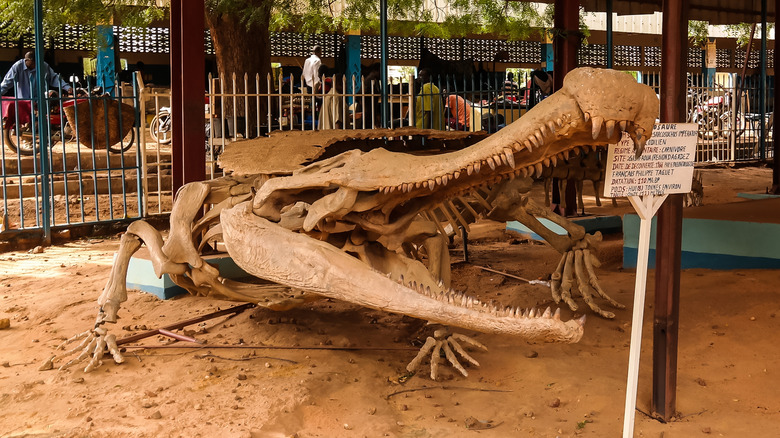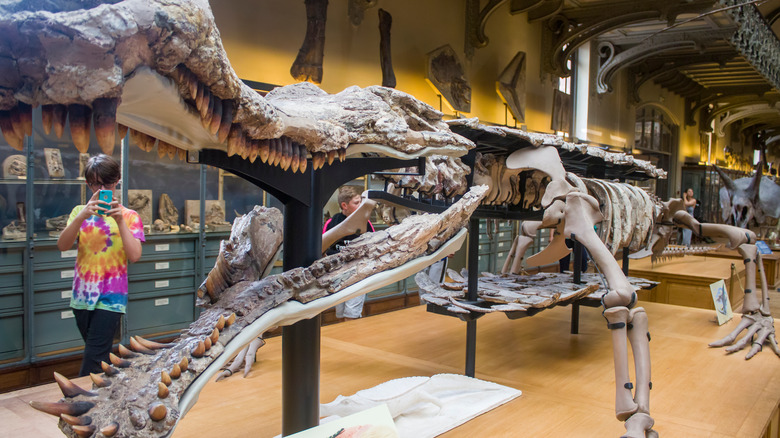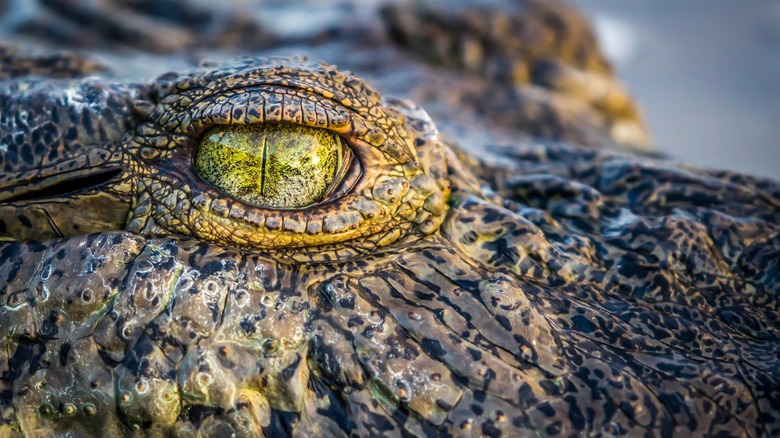Sarcosuchus: The 40-Foot-Long Prehistoric Monster Crocodile That Hunted Dinosaurs
Planet Earth has been home to some of the most beautiful and terrifying creatures that we can think of, some of which are long dead, left for people today to piece together how grandiose they actually were. One of those creatures was the Sarcosuchus, also known as the "super croc." These colossal beasts weighed more than 17,000 pounds and were 40 feet long, primarily preying on dinosaurs, according to ATI.
Most of these fossils have been found in West Africa, and date back 113 million years ago to the Cretaceous period (via Science Focus). This would've predated the dinosaur extinction by roughly 50 million years, and makes the fossils roughly 23 million years older than the infamous tyrannosaurus rex, better known as "T-Rex," according to the American Museum of Natural History. It is believed that these beasts traveled through expansive river deltas that connected Africa and South America when they were one continent. During this time, giant fish that got the size of great white sharks called coelacanths also shared the water with the Sarcosuchus, which might've led to some resource conflict.
Sarcosuchus's diet
It is believed that Sarcosuchus's diet probably contained a little bit of everything. What made these creatures unique was that when they were younger, their snouts were often elongated and narrower, and as they grew older, the snout became flatter, which might have allowed them to eat bigger prey, such as dinosaurs. Scientists hypothesize that the Sarcosuchus probably ate fish in the rivers when it was younger, and as it got to be an adult, its diet would expand to whatever it could get in its mouth, according to Science Focus.
Scientists struggle with fully understanding the Sarcosuchus due to the fact that there is no living descendant of the beast. No other animal has such a unique snout, and on top of that, there are no ball-and-socket joints in this creature like in other crocodiles. But these aren't the only fundamental differences between the Sarcosuchus and its modern-day cousins; things such as age and growth were also very unique to the "super croc" (via Prehistoric Wildlife).
Differences with distant relatives
The fossils that have been found of fully grown Sarcosuchus adults have shown that these creatures could very well live up to 40 years old, and it's likely they could be even older than that, according to Prehistoric Wildlife. This contrasts with modern crocodiles today, given that most live to be up to 25 years. Another interesting feature of the Sarcosuchus was that it seemingly never stopped growing, unlike other crocodiles that stop growing once they reach a certain age, similar to humans. Scientists believe that these ancient crocodiles were able to grow to whatever size their food supply allowed, much similar to the Titanoboa, a 2,500-pound snake that roamed the swamps during the time of the dinosaur (via Prehistoric Wildlife).
Clues about their teeth and jaws have also been able to help scientists in understanding how these fearsome creatures caught their prey, since they have thinner teeth, and their upper jaws curve down allowing them to hook onto fish more easily. Scientists will need more time and research to understand the true monstrosity that was the Sarcosuchus.


